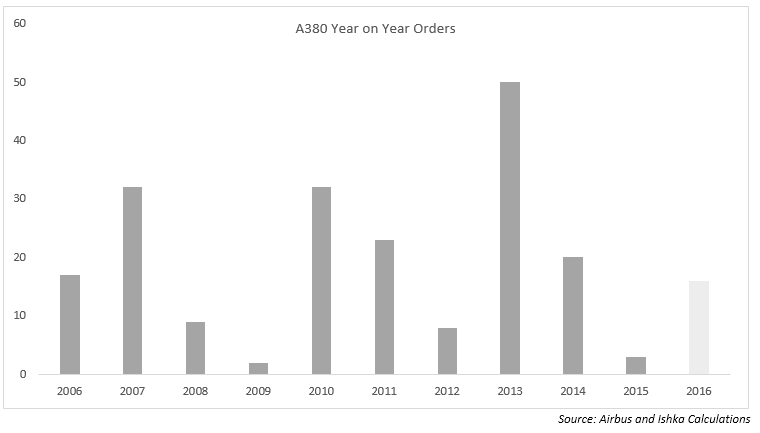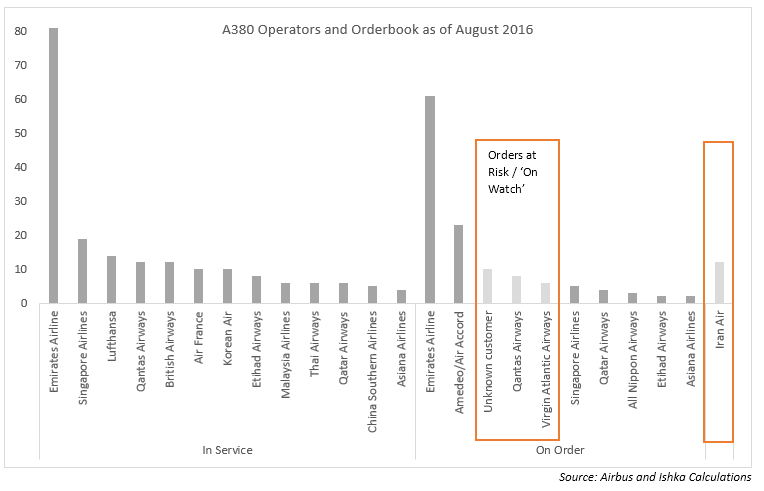Monday 5 September 2016
The Airbus A380 is here to stay despite current challenges

Airbus recently announced that it would reduce the production rate of the A380s to 12 per year by 2018. This is a significant reduction considering it had produced between 26 and 31 aircraft per year for the last three years. Ishka believes this to be a sensible step by Airbus to manage production in-line with near term demand. While the reduction in production is not something to be celebrated, it also does not suggest that the A380 programme’s termination is imminent.
Even though today’s route and traffic developments favour the twin-engine models, Ishka believes that there remains a wider market requirement for a large aircraft type. The A380’s ability to carry more than 550 passengers (significantly more in some configurations) with wide-ranging cabin flexibility is enough of a differentiating factor for the aircraft vis-à-vis today’s twin-engine aircraft. The immediate future may not be looking particularly promising for the A380, however Ishka believes that a longer term future for the aircraft still exists.
Passengers love it but do airlines?
The world’s largest commercial aircraft has a significant fan-base among passengers, thanks to its spacious interiors and modern IFE systems. However, some airlines have been less enthusiastic about the aircraft. Ironically, the size of the A380 is also considered a weakness. Outside of approximately 100 key routes, airlines are apprehensive of having to be able to consistently fill up an aircraft that can seat more than 500 passengers. In addition, the aircraft is so large that airports have had to adapt their operations and invest in infrastructure to make themselves compatible with the A380. Ishka believes that this could in part be one of the reasons why the aircraft has not gathered more traction.
Falling sales figures
As mentioned in our earlier reports in the asset series, today’s market dynamics appear to favour twin-engine aircraft. As a result, both, the A380 and Boeing 747-8 orderbooks have stalled due to competition from the twin-engine long-haul aircraft.
Airbus has, in hindsight, significantly over-estimated the early-years potential demand for the A380 – at the start of the programme Airbus predicted it would sell around 1,200 A380s over the first 20 years but has only managed to sell around 360 after the first decade of the aircraft’s operation.
Nevertheless, there are reasons for optimism with the A380. While the 747-8 has around 10 outstanding secure orders - Airbus has at least 100 similarly secure orders for the A380, albeit the bulk of these are from a single airline, Emirates, which is already the largest operator. In addition, Airbus has managed to secure a potential order for 12 A380s (as part of a larger 118 aircraft-order) for Iran Air at the start of 2016. However, there are concerns that Iran Air could cancel the A380 component, which is still subject to OFAC approval.
Emirates has made the A380 an essential part of its route network from its base in Dubai. In many cases the airline has a monopoly on most of the routes where it deploys the A380, including several short-haul routes. As a result, it is not surprising that Emirates dominates the A380 programme. However, there is a promising business case for replicating the Dubai hub model in Southeast Asia and even in China and Northeast Asia as passenger demand rises and airports struggle with movement and schedule constraints. However, this could take years to materialise and Airbus needs to find a way to keep the production of the A380 going until then. At its current production rate, Airbus could exhaust the orderbook by 2019.
Ishka believes that Airbus has approximately 100 relatively secure aircraft orders in its orderbook while several other A380 orders look increasingly unlikely to be delivered unless market conditions change. Two of the A380’s major customers, Qantas and Virgin Atlantic, with eight and six A380s on order, respectively, have announced further delivery deferrals. In reality, these two airlines are more likely to cancel their orders altogether and/or swap the positions into other models.
Airbus has also kept one order for 10 A380s on its books from an ‘unknown customer’ despite it originally being an order from Hong Kong Airlines which was subsequently cancelled. Iran Air’s order also remains unconfirmed and there are several regulatory hurdles to clear before Airbus can add that order firmly to its backlog.
The A380 programme has also been unfortunate to have had three carriers from its orderbook to go bankrupt. Russia’s Transaero Airlines had orders for four A380s, India’s Kingfisher Airlines had orders for ten and Japan’s Skymark Airlines had six, all of which were subsequently cancelled. They collectively represented around 16% of the aircraft’s current orderbook and therefore constitute a substantial loss of potential revenue for Airbus. However, there are also some positive developments. Amedeo, the Dublin based lessor, placed a speculative order for 20 A380s in 2014 which may help widen the operator base should market conditions allow.
A380s to avoid the fate of the 747-8
Unlike the 747-8, the A380 is a completely new ‘clean sheet’ aircraft design. Even in terms of seating capacity, the Airbus’ aircraft can seat substantially more passengers. As per Boeing, the 747-8 can seat around 450-470 passengers in a three-class configuration while the A380 can conservatively handle up to 550 passengers in the same configuration. The largest new twin-engine jets, such as the 777-9x can only seat around 400 passengers. This puts the A380 in a class of its own. However, there are relatively few routes that are dense enough to consistently fill the A380, which renders it uneconomical on many routes – for now.
In some respects, the A380 was probably ahead of its time. Airbus predicts that the number of aviation ‘mega-cities’ like London, New York and Beijing, which handle tens of thousands of passengers daily, will increase dramatically. When this happens airlines will need larger aircraft like the A380. Until then Airbus has to find a way to keep the programme alive. By lowering the production rate to 12 per year from around 26-28 in 2015, Airbus hopes to buy itself some time to manufacture and deliver the remaining A380s, with an upgraded version to follow later. This would suit some airlines too, many of whom do not yet require A380 type capacity on their routes. But slowing down the A380 production rate poses a problem for Airbus as the programme is said to break even at 27 units per year. It is not yet clear how Airbus can slow the production rate and still make the A380 profitably.
A380neo and the rise of second hand A380s
There have been growing calls for Airbus to launch a more fuel-efficient ‘neo’ variant of the A380, especially from Emirates. However, Emirates is already facing capacity constraints at Dubai International Airport for its current influx of A380s. In the meantime, Airbus recently postponed plans to develop a new version of the A380, with new engines and featuring a small airframe stretch to add up to 56 seats and consequently reduce seat-mile costs even further.
Another dynamic which will have an impact on the future of the programme is the development of an aftermarket for used A380s. Many airlines cannot afford (or do not need) a new A380 but could conceivably operate a relatively cheaper used model. This aftermarket has yet to develop as we are still early in the production life of the aircraft. 2017 may prove to be the first real testing ground.
The Ishka View
The current A380 programme is primarily being influenced by changing market dynamics and fuel prices, rather than by any shortcomings with the aircraft. Many airlines currently find it more economical to operate widebody twin-engine aircraft with a smaller seating capacity. Unsurprisingly, sales of the A380 and Boeing’s 747-8 have yet to live up to expectations. The 747-8 programme is clearly in the final stages of its lifecycle with limited economic rationale to keep the line open. However, Ishka believes that the A380 does have medium to long-term potential. With the pace at which air travel is growing, there will be an increase in passenger traffic between major cities as they will also grow in size and population. At some point this rise in passenger demand, coupled with airport congestion, will translate to more demand for larger aircraft and the A380 remains the obvious model to fill that gap. The question is whether Airbus can support the programme until then.
Ishka believes Airbus’ decision to reduce the production rate is a sensible measure to help sustain the lifecycle of the programme. Airbus’s forecasts have historically perhaps been overly optimistic. Today it believes that by 2035 airlines will need around 1,200 new very large aircraft. If Boeing ends the 747-8 production soon, which appears likely, then the A380 will be the only very large aircraft left on the market. This could leave Airbus with a brighter future for the A380, despite its near-term challenges.





Sign in to post a comment. If you don't have an account register here.